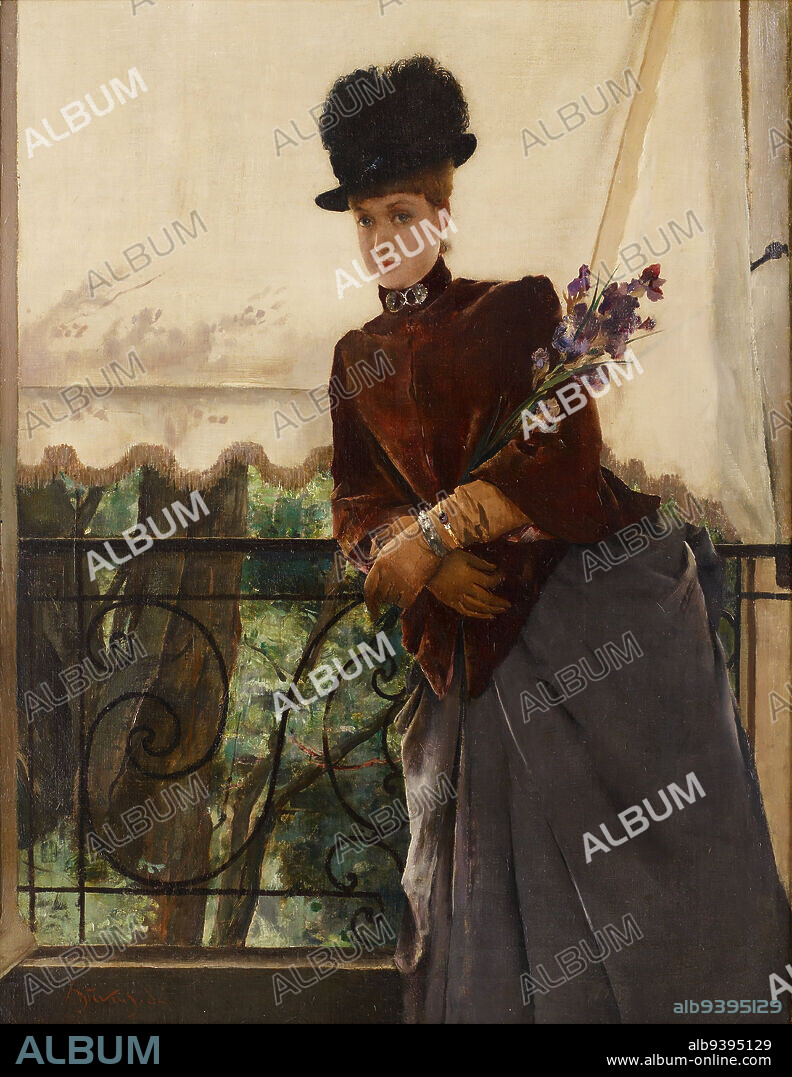alb9395129
Portrait of Mademoiselle Dubois, 1884, Alfred Stevens, Belgian, 1823 - 1906, 27 1/2 x 21 7/16 in. (69.85 x 54.45 cm) (sight)33 1/2 x 27 7/16 in. (85.09 x 69.69 cm) (outer frame), Oil on canvas, Belgium, 19th century, Alfred Stevens built his reputation based on paintings of sumptuously attired, anonymous beauties who were representative of a type-la belle Parisienne. The Portrait of Mademoiselle Dubois, in contrast, is a bold statement built upon direct observation of one of his students with whom he was well acquainted. Her appraising and direct gaze, as well as her relaxed posture and confident demeanor, is a daring concoction and testifies to the artist's appreciation of her intelligence and character. These qualities are thrown into high relief by the stark expanse of awning behind her. Stevens' use of such a bold foil is an innovative touch of modernity that parallels those of his close friend, Edouard Manet. The compressed space also betrays Stevens' interest in Japanese spatial construction-a reminder that he was one of the first artists in Paris (along with Manet) to collect Japanese prints and objects.

|
Ajouter à une autre Lightbox |
|
Ajouter à une autre Lightbox |



Avez-vous déjà un compte? S'identifier
Vous n'avez pas de compte ? S'inscrire
Acheter cette image.
Sélectionnez l'usage:

Légende:
Voir la traduction automatique
Portrait of Mademoiselle Dubois, 1884, Alfred Stevens, Belgian, 1823 - 1906, 27 1/2 x 21 7/16 in. (69.85 x 54.45 cm) (sight)33 1/2 x 27 7/16 in. (85.09 x 69.69 cm) (outer frame), Oil on canvas, Belgium, 19th century, Alfred Stevens built his reputation based on paintings of sumptuously attired, anonymous beauties who were representative of a type-la belle Parisienne. The Portrait of Mademoiselle Dubois, in contrast, is a bold statement built upon direct observation of one of his students with whom he was well acquainted. Her appraising and direct gaze, as well as her relaxed posture and confident demeanor, is a daring concoction and testifies to the artist's appreciation of her intelligence and character. These qualities are thrown into high relief by the stark expanse of awning behind her. Stevens' use of such a bold foil is an innovative touch of modernity that parallels those of his close friend, Edouard Manet. The compressed space also betrays Stevens' interest in Japanese spatial construction-a reminder that he was one of the first artists in Paris (along with Manet) to collect Japanese prints and objects.
Crédit:
Album / quintlox
Autorisations:
Modèle: Non - Propriété: Non
Questions sur les droits?
Questions sur les droits?
Taille de l'image:
3714 x 4803 px | 51.0 MB
Taille d'impression:
31.4 x 40.7 cm | 12.4 x 16.0 in (300 dpi)
Mots clés:
BELGE • BELGIQUE • CARACTÈRE • HUILE • INTELLIGENCE • MANAGER • MARQUISE (AUVENT) • OBJETS • PARIS • PARIS, FRANCE • PORTAIT • PORTRAIT • POTRAIT • TOILE • XIXE SIÈCLE
 Pinterest
Pinterest Twitter
Twitter Facebook
Facebook Copier le lien
Copier le lien Email
Email
